Samskaras
- There are 16 samskaras or rites of passage in a Hindu’s life.
- Nine of these samskaras take place during the early years of a Hindu’s life.
Birth & Naming
9 of the samskaras take place during early years.
Some of the most significant ones include.
- The child’s head is shaved. This symbolises the removal of bad karma from previous lives.
- Aum is written on the baby’s tongue in honey – this means that the child will associate the sound with sweetness.
Upanayana
- Upanayana is the 10th samskara and marks beginning of the student Ashrama.
- Traditionally Upanayana was for brahmin, kshatriya and vaishya boys though now girls and some shudra and harijan boys also receive it.
- Boys (and girls) take the thread aged 8-16
Sacred Thread
The Ceremony
- The head is shaved leaving a tuft on the crown.
- The boy washes & puts on a special dhoti.
- The boy shares a special meal with his mother.
- The priest conducts a homa (special ritual with sacred fire.)
- The boy is given new clothes and the sacred thread is placed over his left shoulder so that it hangs diagonally across his chest to his right side.
- The thread is worn for the rest of his life but will be replaced annually on Ganesha’s birthday.
The Meaning
The 3 threads are said to signify the Tri-murti of Brahma, Vishnu & Shiva and the 3 obligations
- 1. The obligation to promote knowledge.
- 2. The obligation to respect & care for parents and elders.
- 3. The obligation towards society.
The ceremony represents the boy moving from his mother’s care to the influence of his male relatives.
The thread is a physical reminder that God is all around you and remind you to control your body, mind and speech.
Marriage
Marriage is viewed as a Gift from God which serves the following purposes.
- To allow the couple to have sex.
- To join two families together.
- To allow the couple to share love & each other’s company.
- To produce children.
- To enable fulfillment of the householder stage of life.
As with all aspects of Hinduism, marriages can be diverse. All Hindu weddings are carried out by a priest.
The couple take seven steps around the Havan or sacred fire as laid down in the Law of Manu.
- The first step is for food
- The second for strength
- The third for wealth
- The fourth for happiness
- The fifth for children
- The sixth for sustenance
- The seventh for unity.
In addition to this they will often throw rice into the Havan to encourage the couple’s fertility, stand on a rock to represent the stability which marriage will bring to their lives, make offerings to deities and have prayers and hymns.
Funeral

Death
Cremation is the 16th & final samskara.
Dead bodies are washed, clothed in a new shroud and taken to a funeral pyre for cremation.
The eldest son walks around the pyre with a lighted torch to prevent the soul returning to Earth as a ghost. He pours ghee on the pyre as an offering to Agni the fire god.
The heat of the fire makes the skull crack and it is believed that at this point the Atman escapes.
Shraddha
- Shraddha is the practice of widows throwing themselves onto their husband’s funeral pyres.
- This practice has now been outlawed in India and is incredibly rare.
Death in the UK
In the UK outdoor cremations are illegal so British Hindus would place the body into a coffin and have it cremated at the local crematorium.
Ashes are usually scattered into one of India’s holy rivers and many British Hindus arrange to have ashes sent to India for scattering.
